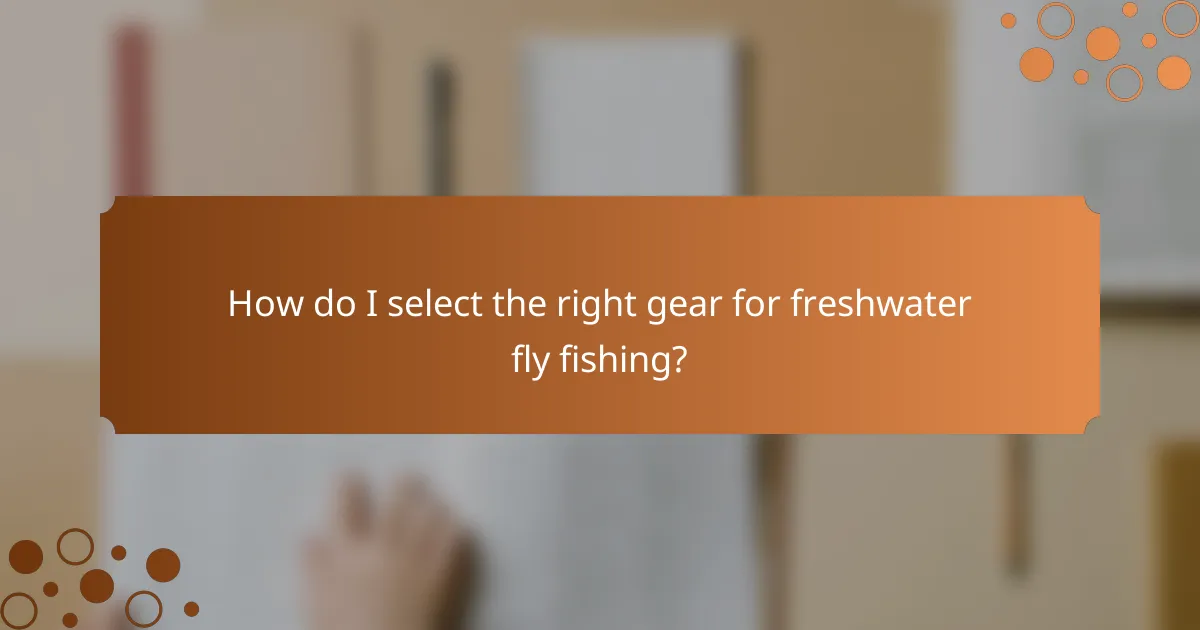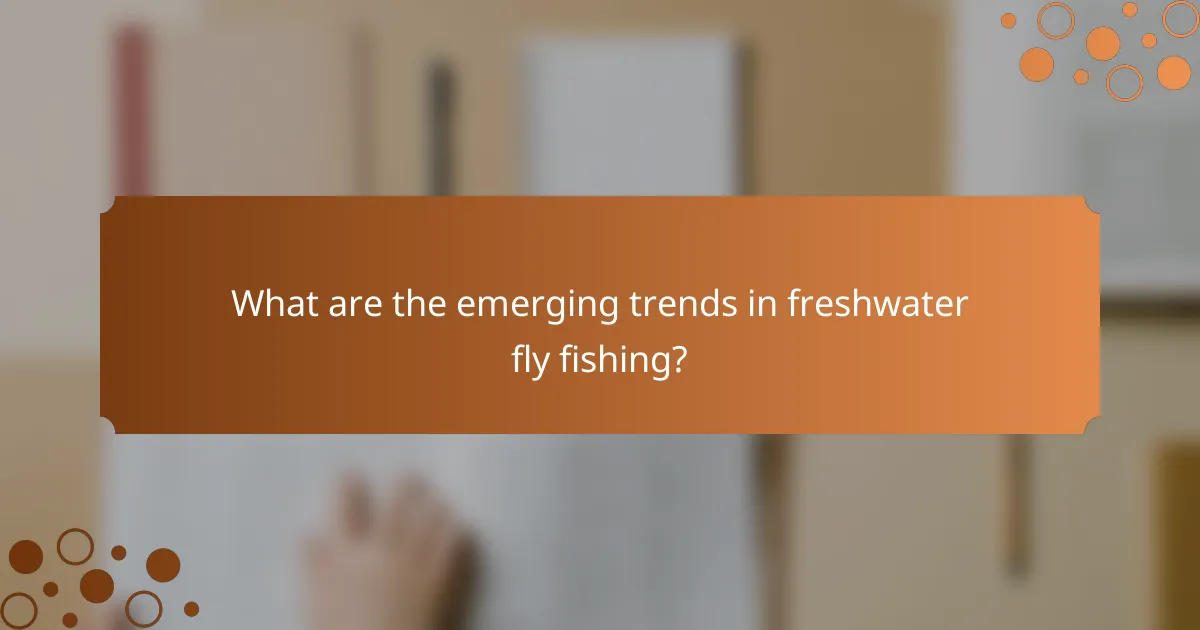Fly fishing in freshwater offers a diverse range of techniques, including dry fly fishing, nymph fishing, and Euro nymphing, each tailored to specific fish behaviors and environments. Choosing the right gear, such as rods, reels, and fly patterns, is crucial for enhancing your fishing experience. Additionally, mastering casting skills is essential for accurate line placement, ensuring your fly is presented naturally to attract fish effectively.

What are the best freshwater fly fishing techniques?
The best freshwater fly fishing techniques include dry fly fishing, wet fly fishing, nymph fishing, streamer fishing, and Euro nymphing. Each method targets different fish behaviors and habitats, requiring specific skills and gear for success.
Dry fly fishing
Dry fly fishing involves using floating flies that imitate insects on the water’s surface. This technique is effective during hatches when fish are actively feeding on top. Key considerations include matching the fly to the local insect life and using a delicate presentation to avoid spooking fish.
To improve your success, focus on casting accuracy and timing. Observe the water for rising fish and be ready to cast your fly just upstream of them. Avoid heavy tippets, as lighter lines can enhance the natural drift of your fly.
Wet fly fishing
Wet fly fishing uses flies that sink below the surface, mimicking aquatic insects or baitfish. This method is particularly useful in faster currents where fish may not be feeding on the surface. Techniques include swinging the fly across the current or retrieving it with short pulls.
When selecting wet flies, consider patterns that match local forage. Use a floating line with a tapered leader to help the fly sink and maintain a natural movement. Be mindful of the water depth and adjust your retrieve speed accordingly.
Nymph fishing
Nymph fishing targets fish feeding below the surface with flies designed to imitate immature insects. This technique is often the most productive, especially in rivers with significant insect populations. Key to success is understanding the water column and where fish are likely to be holding.
Use a strike indicator to detect subtle bites, and consider using split shot weights to help your nymph reach the desired depth. Experiment with different patterns and sizes to find what works best for the specific water conditions.
Streamers fishing
Streamer fishing involves using larger, often more aggressive flies that imitate baitfish or larger prey. This technique is effective for targeting predatory species like trout and bass. Streamers can be fished through various retrieves, including stripping and swinging.
Choose streamers that match the local forage size and color. Vary your retrieve speed and action to entice strikes, especially in deeper water where fish may be lurking. Be prepared for aggressive takes, and use a sturdy rod and tippet to handle larger fish.
Euro nymphing
Euro nymphing is a specialized technique focusing on tight-line nymphing with minimal slack in the line. This method allows for precise control and sensitivity, making it effective in fast-moving water. Key elements include using a longer rod and a thin, high-visibility leader.
To practice Euro nymphing, focus on maintaining a direct connection to your fly and monitoring for subtle bites. Adjust your weight and fly selection based on water conditions, and be prepared to adapt your technique as needed for different streams and rivers.

How do I select the right gear for freshwater fly fishing?
Selecting the right gear for freshwater fly fishing involves understanding the specific components that enhance your experience on the water. Key elements include the fly rod, reel, line, and fly patterns, each playing a critical role in your overall success.
Choosing the right fly rod
The fly rod is fundamental to your fishing setup, affecting casting distance and accuracy. For freshwater fishing, rods typically range from 8 to 9 feet in length, with a weight of 4 to 6 being ideal for most species.
When selecting a rod, consider the type of fish you are targeting and the environment. A medium-action rod offers versatility, while a fast-action rod provides better performance in windy conditions. Always test the rod’s feel before purchasing to ensure comfort and control.
Selecting fly reels
Your fly reel should balance well with your rod and hold enough line to accommodate your fishing style. Look for reels that are lightweight yet durable, typically made from aluminum or composite materials.
For freshwater fishing, a reel with a smooth drag system is essential to manage the fight of the fish. Ensure the reel’s size matches the rod weight; a 5-weight rod pairs well with a 5-weight reel. Avoid overly complex mechanisms; simplicity often leads to reliability.
Understanding fly lines
Fly lines are crucial for casting and presentation, with options including floating, sinking, and intermediate lines. Floating lines are most common for freshwater fishing, allowing for versatile techniques.
Choose a line weight that matches your rod and reel setup. For example, a 5-weight rod should use a 5-weight line. Pay attention to the taper design, as it affects how the line casts and presents the fly. A weight-forward taper is excellent for distance, while a double taper offers better control for delicate presentations.
Essential fly patterns
Choosing the right fly patterns is vital for attracting fish. Common freshwater patterns include dry flies, nymphs, and streamers, each mimicking different stages of aquatic life.
Start with a selection of versatile patterns like the Adams dry fly, Pheasant Tail nymph, and Woolly Bugger streamer. It’s wise to have a variety of sizes and colors to adapt to changing conditions. Always consider local hatches and fish preferences to increase your chances of success.

What are effective casting skills for fly fishing?
Effective casting skills for fly fishing involve mastering techniques that allow for accurate and controlled line placement. These skills are essential for presenting the fly naturally to fish, increasing the chances of a successful catch.
Basic casting techniques
Basic casting techniques include the overhead cast and the roll cast, both fundamental for fly fishing. The overhead cast involves a smooth motion that propels the line forward, while the roll cast is useful in tight spaces where backcasting is limited.
When practicing these techniques, focus on your wrist and arm movements. A common mistake is using too much force; instead, aim for a fluid motion to maintain control and accuracy.
Roll cast fundamentals
The roll cast is particularly effective in situations where you cannot cast backward, such as when surrounded by trees or bushes. To execute a roll cast, start with the line on the water and lift it to create a D-loop before casting forward.
Key considerations include keeping the rod tip low and using a smooth, continuous motion. Practicing this technique can enhance your ability to present the fly in challenging environments.
Double haul technique
The double haul technique is an advanced casting skill that increases line speed and distance. It involves pulling on the line with your non-dominant hand while simultaneously casting with your dominant hand, creating a more powerful stroke.
To master the double haul, practice coordinating both hands. Start with a basic cast and gradually incorporate the haul, focusing on timing and rhythm. This technique can significantly improve your casting efficiency, especially in windy conditions.

What prerequisites should I consider before fly fishing?
Before starting fly fishing, it’s essential to understand local regulations, assess water conditions, and select appropriate gear. These factors will significantly influence your success and enjoyment while fishing.
Understanding local regulations
Familiarizing yourself with local fishing regulations is crucial. These rules can include specific seasons, catch limits, and designated fishing areas. For instance, some regions may require a fishing license or have restrictions on certain species.
Check with local wildlife agencies or fishing organizations for the most current regulations. Ignoring these rules can lead to fines or other penalties, so always ensure compliance before heading out.
Assessing water conditions
Water conditions play a vital role in fly fishing success. Factors such as water temperature, clarity, and flow rate can affect fish behavior and feeding patterns. Generally, fish are more active in cooler waters, while warmer temperatures may slow them down.
Before fishing, observe the water’s surface for signs of insect activity or fish rising. This can help you choose the right flies and techniques. Additionally, be aware of weather conditions, as changes can impact water levels and fish activity.

How do I improve my fly fishing experience in freshwater?
To enhance your fly fishing experience in freshwater, focus on refining your techniques, selecting the right gear, and utilizing local resources. Understanding the environment and engaging with the community can significantly boost your success and enjoyment.
Utilizing technology for fishing
Incorporating technology can greatly enhance your fly fishing experience. Tools such as fish finders, weather apps, and GPS devices help you locate fish and understand conditions better. For instance, using a weather app can inform you about optimal fishing times based on temperature and barometric pressure.
Additionally, online platforms and mobile applications provide access to fishing reports and local regulations. These resources can guide you to the best spots and inform you about seasonal changes in fish behavior, ensuring you are well-prepared for your outings.
Joining local fishing communities
Becoming part of local fishing communities can provide valuable insights and support. Engaging with fellow anglers through clubs or online forums allows you to share experiences, tips, and techniques. This networking can lead to discovering new fishing locations and learning about local species.
Participating in community events, such as workshops or fishing tournaments, can also enhance your skills. These gatherings often feature experienced anglers who can offer hands-on guidance and advice tailored to your specific freshwater environment.

What are the emerging trends in freshwater fly fishing?
Emerging trends in freshwater fly fishing include the increasing popularity of catch-and-release practices, the use of innovative gear, and a focus on sustainable fishing methods. Anglers are now more aware of environmental impacts and are adapting their techniques to promote conservation.
Innovative Gear and Technology
New technologies are shaping the gear used in freshwater fly fishing, with advancements in rod materials and reel designs enhancing performance. Lightweight, durable materials like carbon fiber are becoming standard, allowing for longer casts and better sensitivity. Additionally, smart fishing gadgets, such as fish finders and weather apps, are helping anglers make informed decisions on the water.
Sustainable Fishing Practices
Sustainability is a key focus in freshwater fly fishing, with many anglers adopting practices that minimize ecological impact. This includes using barbless hooks to reduce injury to fish and practicing catch-and-release to help maintain fish populations. Anglers are also encouraged to follow local regulations and guidelines to protect aquatic ecosystems.
Increased Interest in Local Species
There is a growing trend towards targeting native fish species in freshwater environments. Anglers are becoming more interested in understanding local ecosystems and the specific needs of indigenous fish. This shift not only promotes biodiversity but also enhances the fishing experience by connecting anglers with their local environment.
Community and Education
Fly fishing communities are increasingly focused on education and sharing knowledge. Workshops, online forums, and local clubs are providing resources for both novice and experienced anglers. These platforms encourage skill development and foster a sense of camaraderie among enthusiasts, promoting a culture of learning and conservation.
